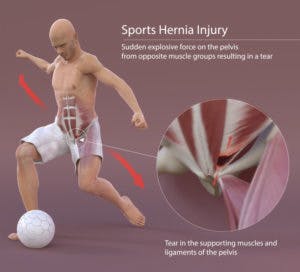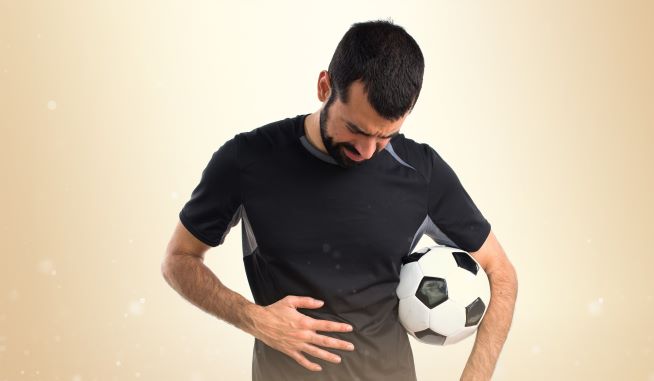Are you an athlete experiencing deep pain in your lower abdomen or groin? A sports hernia is common in athletes who do repetitive kicking, twisting, or turning at high speeds. This includes athletes who play soccer, football, basketball, baseball, tennis, and hockey. Many athletes miss significant playing time due to ongoing pain. This article describes what a sports hernia is. We then highlight 6 exercises to help you get back to playing after a sports hernia.
What is a Sports Hernia?

The injury is called a “hernia”. However, a hernia means a body part or tissue squeezes through a weak area of muscle or fascia. With the common inguinal hernia, part of the intestine pushes through the injured lower abdominal wall. With a sports hernia, this rarely occurs. There is no injury or tearing of the inguinal wall. The injury is to the fascia, muscles, or tendons of the abdomen and pelvis.
With a sports hernia, no organ pushes through the injured tissue. This is why the preferred term is now “athletic pubalgia”.
Proven Treatments for Sports Hernia
Once diagnosed, rehab is recommended for at least 3 to 6 months. If you do not improve with rehab you are a surgical candidate. A 2014 study looked at 100 cases of sports hernia treated with rehab or surgery. Of people undergoing surgery, 94% successfully returned to their pre-injury sport or work. In the rehab group, 93% returned to their pre-injury levels. Therefore, both rehab exercises and surgery are effective treatments for sports hernia.
Phase 1: Early Rehab Exercise for Sports Hernia
Early rehab exercises focus on flexibility, core stability, and hip strength. You should be able to perform these exercises with minimal or no pain. Most exercises involve isometric contractions (static holds) of your lower abdominal and pelvic muscles. Emphasize a neutral spine and slow controlled movements. To start, perform dead bugs, bridging, and plank variations. Also, consider other abdominal and hip strengthening exercises. Within a few weeks, you will be feeling better and stronger.
Perform the initial exercises with special attention to proper technique and building endurance. These exercises lay the foundation for more advanced exercises to come. We recommend 2 to 3 sets of 12 to 20 repetitions for each exercise. Perform them daily.
Phase 2: Exercise Progressions
After you have adequate core stability and hip strength, you are ready to progress. The next phase of rehab involves rotational movements. This is because sports hernia injuries often result from pivoting or twisting. Examples are kicking a soccer ball or swinging a baseball bat. Single-leg exercises are also very important during this phase. Lunges, split squats, single-leg deadlifts, and single-leg squats help prepare you for returning to your sport.
Balance, control, and endurance are important aspects of these exercises. Perform 2 to 3 sets of 10 to 12 repetitions. Perform them 3 to 4 days per week. You can continue performing any stretching and phase 1 exercise on alternate days. Also, before returning to sport your physical therapist will put you through agility and plyometric training.
Final Thoughts on Exercises for Sports Hernia
Core and hip strengthening exercises are proven treatments to get you back to playing after a sports hernia. The 6 sports hernia exercises in this article are a sample of many effective options. You will also benefit from receiving manual therapy performed by your physical therapist.
As always, your symptoms and goals dictate the approach that is best for you. So commit to your exercises for at least 6 weeks. If you would like help getting started, call our office to schedule an initial evaluation with your physical therapist.

